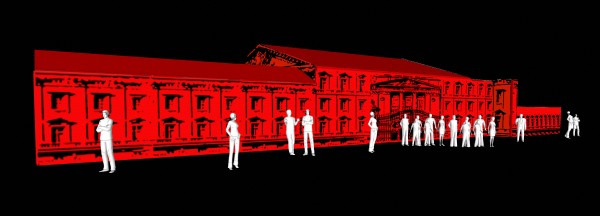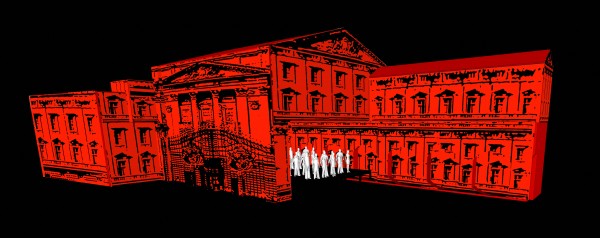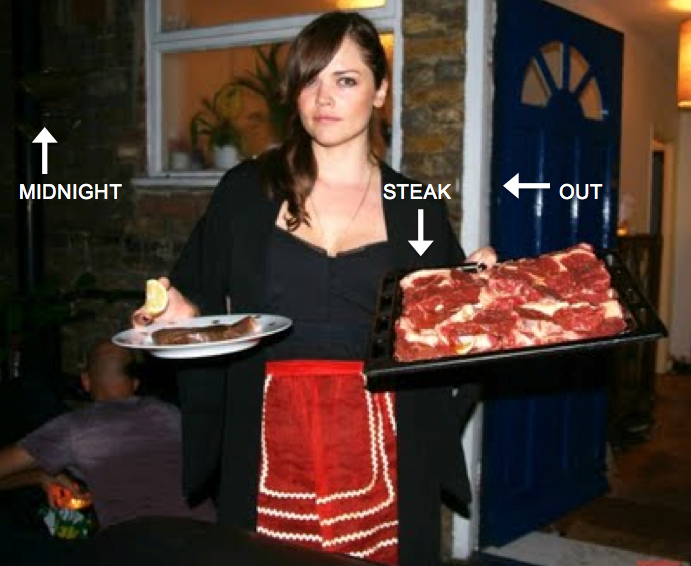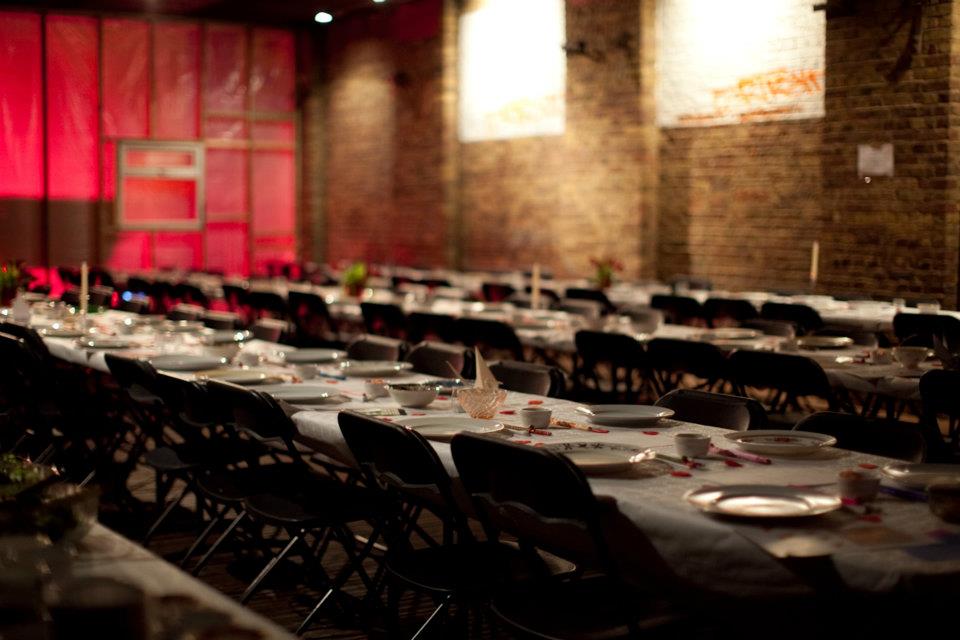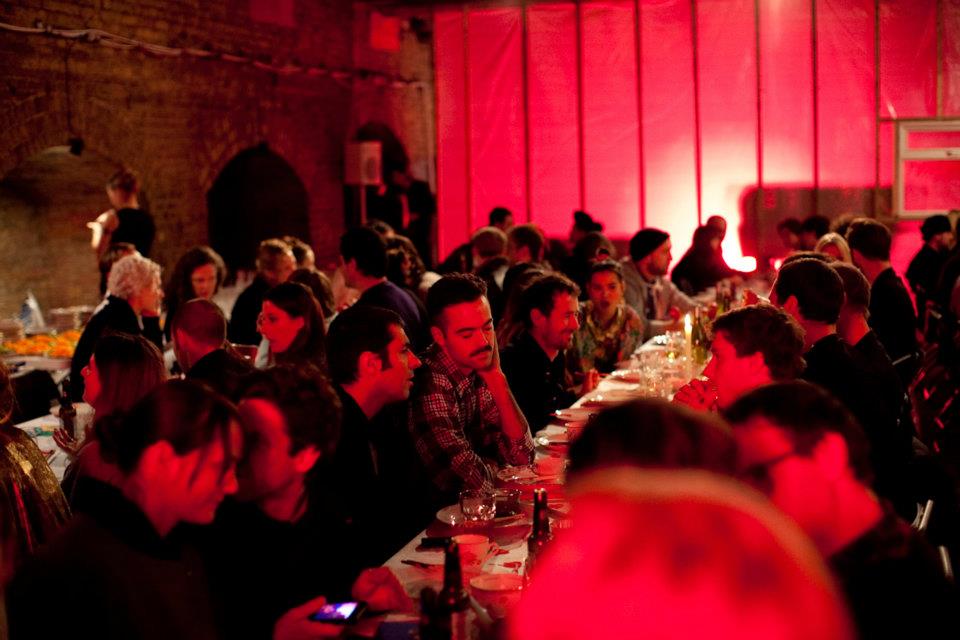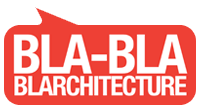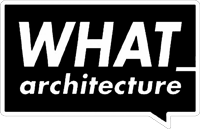139you_product placement
The forthcoming Olympics in East London has resulted in many global sporting brands looking for new ways to position their product. With a possible development of a mixed use retail-office-recreational space at Shoreditch Station, ‘train’ and ‘trainer’ will be symbiotically linked.
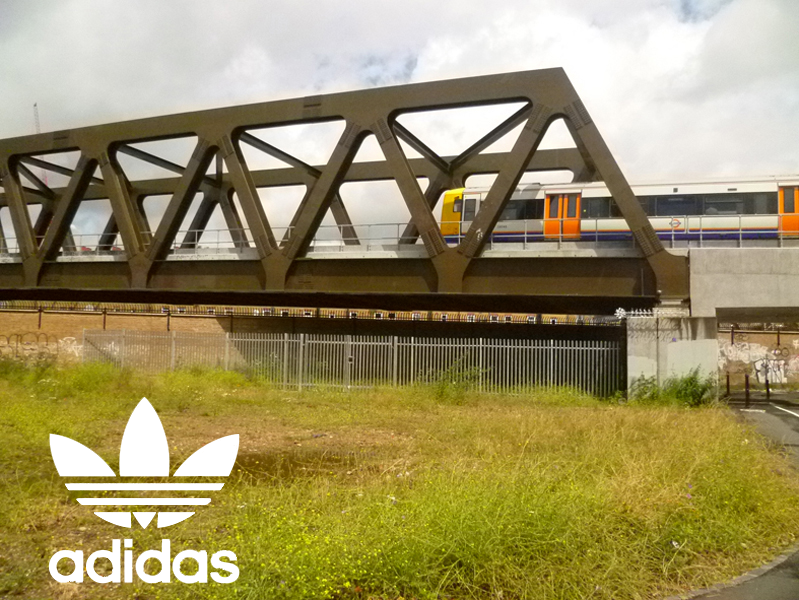
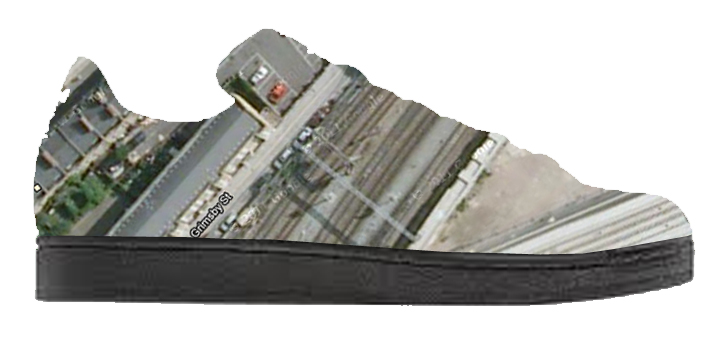



128art_TALKING BUILDINGS: FAÇADE TAGGING IN THE INFORMATIONAL AGE.
Local Authority Partnering Guidelines are being drafted by WHAT_architecture in response to receiving a LBTH Defacement Notice from the Council in late 2011. This notice was served because a “Sign/Graffiti’ (informal or illegal marks, drawings or paintings) have been deliberately made known” and that this is “a blight on the local environment which the Council considers to be detrimental to the amenity of the area or offensive.”
So what does the Council consider detrimental or offensive? The Council’s own website clarifies the latter as being either racist or obscene. Fair cop there. Regarding detriment, then this is a concept relative to context. It’s difficult to say that non-offensive graffiti is detrimental to a pissoir alleyway locally referred to as ‘piddle street’. The council is however concerned about the ‘knock-on’ effect of graffiti: street art which could inspire tagging. And tagging is not only bad but it’s banal. However associating one event on another is akin to suggests that watching Terminator might lead one on a copy-cat gun-rampage. The ‘broken windows theory’ described by social scientists James Q. Wilson and George L. Kelling asks us to “consider a building with a few broken windows. If the windows are not repaired, the tendency is for vandals to break a few more windows. Eventually, they may even break into the building, and if it’s unoccupied, perhaps become squatters or light fires inside. Or consider a sidewalk. Some litter accumulates. Soon, more litter accumulates. Eventually, people even start leaving bags of trash from take-out restaurants there or breaking into cars.”



 Talking buildings. Or rather buildings that talk to you: graffiti. The etymology of the word graffiti derives from the Italian graffito (meaning “scratched”) where designs were scratched or inscribed into a surface. The earliest forms of graffiti date back to 30,000 BCE in the form of prehistoric cave paintings and pictographs using tools such as Animal bones and pigments. These illustrations were often placed in ceremonial and sacred locations inside of the caves. The images drawn on the walls showed scenes of animal wildlife and hunting expeditions in most circumstances.
Talking buildings. Or rather buildings that talk to you: QR codes. QR Codes are being used to facilitate planning protests by embedding meta-data and text into physical spaces. In 2011, New York City Mayor Mike Bloomberg unveiled a system of QR tags meant to give citizens quicker access to information about new construction projects. The QR codes are posted on every construction permit city-wide; by downloading a QR reader app on any smartphone, city-goers can scan these codes to see a web view of what’s being built, who is doing the building, and what (if any) complaints have been filed against the applicant. C’mon London: printing QR codes on Public Notices costs the Local Authority nothing… but engages wider public opinion!
Talking buildings. Or rather buildings that talk to you: graffiti. The etymology of the word graffiti derives from the Italian graffito (meaning “scratched”) where designs were scratched or inscribed into a surface. The earliest forms of graffiti date back to 30,000 BCE in the form of prehistoric cave paintings and pictographs using tools such as Animal bones and pigments. These illustrations were often placed in ceremonial and sacred locations inside of the caves. The images drawn on the walls showed scenes of animal wildlife and hunting expeditions in most circumstances.
Talking buildings. Or rather buildings that talk to you: QR codes. QR Codes are being used to facilitate planning protests by embedding meta-data and text into physical spaces. In 2011, New York City Mayor Mike Bloomberg unveiled a system of QR tags meant to give citizens quicker access to information about new construction projects. The QR codes are posted on every construction permit city-wide; by downloading a QR reader app on any smartphone, city-goers can scan these codes to see a web view of what’s being built, who is doing the building, and what (if any) complaints have been filed against the applicant. C’mon London: printing QR codes on Public Notices costs the Local Authority nothing… but engages wider public opinion!
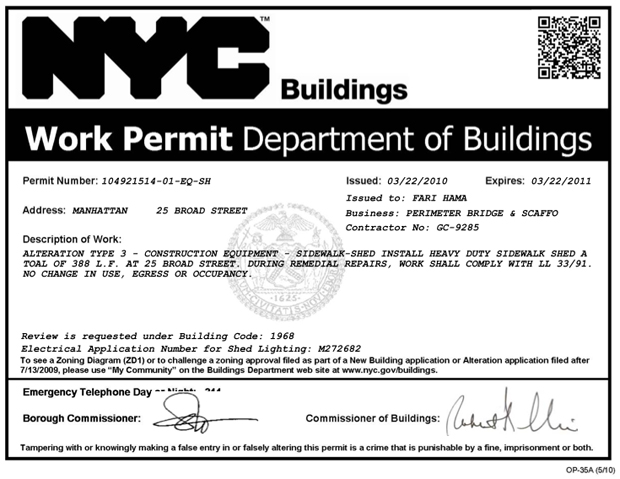



 Talking buildings. Or rather buildings that talk to you: graffiti. The etymology of the word graffiti derives from the Italian graffito (meaning “scratched”) where designs were scratched or inscribed into a surface. The earliest forms of graffiti date back to 30,000 BCE in the form of prehistoric cave paintings and pictographs using tools such as Animal bones and pigments. These illustrations were often placed in ceremonial and sacred locations inside of the caves. The images drawn on the walls showed scenes of animal wildlife and hunting expeditions in most circumstances.
Talking buildings. Or rather buildings that talk to you: QR codes. QR Codes are being used to facilitate planning protests by embedding meta-data and text into physical spaces. In 2011, New York City Mayor Mike Bloomberg unveiled a system of QR tags meant to give citizens quicker access to information about new construction projects. The QR codes are posted on every construction permit city-wide; by downloading a QR reader app on any smartphone, city-goers can scan these codes to see a web view of what’s being built, who is doing the building, and what (if any) complaints have been filed against the applicant. C’mon London: printing QR codes on Public Notices costs the Local Authority nothing… but engages wider public opinion!
Talking buildings. Or rather buildings that talk to you: graffiti. The etymology of the word graffiti derives from the Italian graffito (meaning “scratched”) where designs were scratched or inscribed into a surface. The earliest forms of graffiti date back to 30,000 BCE in the form of prehistoric cave paintings and pictographs using tools such as Animal bones and pigments. These illustrations were often placed in ceremonial and sacred locations inside of the caves. The images drawn on the walls showed scenes of animal wildlife and hunting expeditions in most circumstances.
Talking buildings. Or rather buildings that talk to you: QR codes. QR Codes are being used to facilitate planning protests by embedding meta-data and text into physical spaces. In 2011, New York City Mayor Mike Bloomberg unveiled a system of QR tags meant to give citizens quicker access to information about new construction projects. The QR codes are posted on every construction permit city-wide; by downloading a QR reader app on any smartphone, city-goers can scan these codes to see a web view of what’s being built, who is doing the building, and what (if any) complaints have been filed against the applicant. C’mon London: printing QR codes on Public Notices costs the Local Authority nothing… but engages wider public opinion!


128art_NEW ERA INTRODUCING 2011
Crowds flocked to the private launch of the New Era Introducing 2011 gallery at Shoreditch Underground in the heart of East London before it embarks on a tour across Europe, The Middle East and Africa. We catch up with Lina Al Amoudi, the creative mind behind this year’s winning entry and several other finalists to find out more.

128art_ICON MAGAZINE: CREATE YOUR OWN COVER!
100th issue launch party at Shoreditch Underground: be your own cover star for 15 minutes.

128ART_WOW NOW
 P R E S S R E L E A S E W O W N O W LO N D O N
‘An International exhibition articulating the friction between Outsider, Street & Fine Artvia subversive portraiture’
Featuring:ALEX DAW ( UK ), ZTY 82 ( Germany ), BEN WELLER ( UK ),STEPHEN TOMKINS ( USA ), PERFEKT WORLD ( Austria ),SID ONE ( U K ), PAUL BUSK ( Austria ), NOMAD ( Germany ),TED RIEDERER ( USA ), JAMES JESSOP ( UK ).
Private View / June 1st /Exhibition Open June 2nd – 9th
Shoreditch Underground is delighted to announce the former station come gallery’s first ever Group Show ‘Wow Now’.In the dark depths of a former London Underground station, emerging International Artists collaborate to create an alternate debut exhibition. Referencing roots of the subway graffiti culture of old, against the backdrop of East Londons’ former Shoreditch Tube Station; these young makers challenge themselves and the space with a pop explosionthat pulsates with punk tendencies. Regardless of Environment, location or personal circumstance this group share a desire to document contemporary living and society in all its twisted glory.Inspired by Art history painting, Fashion, Comic books,Graffiti to Cartoons, Drugs & Music; these displaced Artists are constantly rewriting their own history with often Machiavellian results. Amalgamations of sculpted paint, glue,collage, photography and everyday ephemera are fused to form a momentary attempt to survey modern society.This cutting edge exhibition will at once introduce multiple reflections of ‘now’, whilst allowing art enthusiasts an opportunity to see some of the most exciting Artists working throughout the globe under and above the radar today.Post Wow Now London, the exhibition will travel to other European Capitals throughout the year. This show promises to be a truly special, one off experience, one definitely not to be missed. To receive an invitation to the exclusive Private View on June 1st please contact info@nowtspecial.co.uk
P R E S S R E L E A S E W O W N O W LO N D O N
‘An International exhibition articulating the friction between Outsider, Street & Fine Artvia subversive portraiture’
Featuring:ALEX DAW ( UK ), ZTY 82 ( Germany ), BEN WELLER ( UK ),STEPHEN TOMKINS ( USA ), PERFEKT WORLD ( Austria ),SID ONE ( U K ), PAUL BUSK ( Austria ), NOMAD ( Germany ),TED RIEDERER ( USA ), JAMES JESSOP ( UK ).
Private View / June 1st /Exhibition Open June 2nd – 9th
Shoreditch Underground is delighted to announce the former station come gallery’s first ever Group Show ‘Wow Now’.In the dark depths of a former London Underground station, emerging International Artists collaborate to create an alternate debut exhibition. Referencing roots of the subway graffiti culture of old, against the backdrop of East Londons’ former Shoreditch Tube Station; these young makers challenge themselves and the space with a pop explosionthat pulsates with punk tendencies. Regardless of Environment, location or personal circumstance this group share a desire to document contemporary living and society in all its twisted glory.Inspired by Art history painting, Fashion, Comic books,Graffiti to Cartoons, Drugs & Music; these displaced Artists are constantly rewriting their own history with often Machiavellian results. Amalgamations of sculpted paint, glue,collage, photography and everyday ephemera are fused to form a momentary attempt to survey modern society.This cutting edge exhibition will at once introduce multiple reflections of ‘now’, whilst allowing art enthusiasts an opportunity to see some of the most exciting Artists working throughout the globe under and above the radar today.Post Wow Now London, the exhibition will travel to other European Capitals throughout the year. This show promises to be a truly special, one off experience, one definitely not to be missed. To receive an invitation to the exclusive Private View on June 1st please contact info@nowtspecial.co.uk
128art_a dance tax!? An economic model.
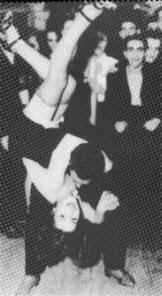 Can we find a win-win situation?
The image looks bleak (a grave rave) unless the designers can find a way for one side (the Local Authority Planners, the Police, the local residents) to be socially and commercially reconciled with the other (ravers, developers, architects, banks, urinoirs…)> at worst, a dance tax… at best, a social upgrade!
In a bid to learn more, we tried a Google search of <dance tax> which only produced a taxing dance: the jitterbug (above) at http://uncyclopedia.wikia.com/wiki/Tax_(dance). This means the taxation of dance music to produce income to service local areas is a novel concept. In searching for guidance, raising social income through dance music to profit from costs, it dawns we are breaking ground… that’s exciting. What can we do to garner a win-win situation? Let’s consider the spatial-economics. A dance/rave/art installation/D1 class use can generate around £25,000 in a day: that’s around £10K from the door and £15K from the bar. So how do you cut the pie? Agree costs. Music (DJs), alcohol (bar), population (door), toilets (inside, outside), fun/hassle (balance)? At what point does a rave become valuable to society? When it generates: £5K? £10K? £50K? £100? £1M? A urinal? a house? a hospital? There’s always a price to pay. To receive.
Can we find a win-win situation?
The image looks bleak (a grave rave) unless the designers can find a way for one side (the Local Authority Planners, the Police, the local residents) to be socially and commercially reconciled with the other (ravers, developers, architects, banks, urinoirs…)> at worst, a dance tax… at best, a social upgrade!
In a bid to learn more, we tried a Google search of <dance tax> which only produced a taxing dance: the jitterbug (above) at http://uncyclopedia.wikia.com/wiki/Tax_(dance). This means the taxation of dance music to produce income to service local areas is a novel concept. In searching for guidance, raising social income through dance music to profit from costs, it dawns we are breaking ground… that’s exciting. What can we do to garner a win-win situation? Let’s consider the spatial-economics. A dance/rave/art installation/D1 class use can generate around £25,000 in a day: that’s around £10K from the door and £15K from the bar. So how do you cut the pie? Agree costs. Music (DJs), alcohol (bar), population (door), toilets (inside, outside), fun/hassle (balance)? At what point does a rave become valuable to society? When it generates: £5K? £10K? £50K? £100? £1M? A urinal? a house? a hospital? There’s always a price to pay. To receive.
128art_Mirage Building
The station is undergoing a transformation. In a bid to elevate this former public building from its currently underutilised status, could the station become as significant as Buckingham Palace or are such delusions merely castles in the air? indeed, should the aspirations of all buildings be architecture?
